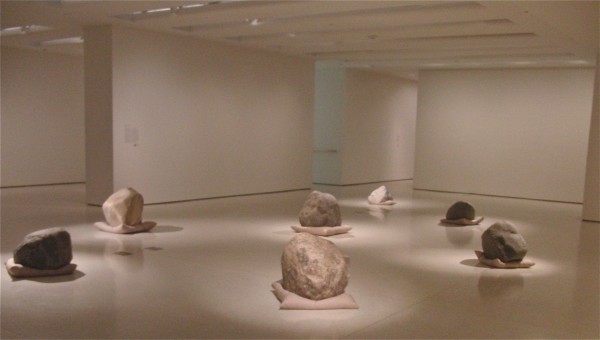
Lee Ufan, “Relatum — silence b,” steel and stone, 2008, and “Dialogue,” oil and mineral pigment on canvas, 2007, installation view (photo by David Heald © Solomon R. Guggenheim Foundation)
Solomon R. Guggenheim Museum
1071 Fifth Ave. at 89th St.
Friday – Wednesday through September 28, $18 (pay-what-you-wish Saturday 5:45-7:45)
212-423-3587
www.guggenheim.org
Two of the first works on view in the Guggenheim’s dazzling retrospective “Lee Ufan: Marking Infinity” sum up much about the Korean-born conceptual artist and philosopher and his work. In “Relatum — silence b,” a stone sits in front of a steel plate that leans against the wall. From certain angles, it appears as if the stone is actually viewing the steel piece, like it is a visitor in an art gallery looking at a painting. However, the public is invited to walk in between the two objects, placing themselves within the work, which, despite consisting of two solid, heavy parts, suddenly seems to mold itself into another being, its physicality shifting as humans interact with nature. Nearby is “Relatum” (formerly “Phenomenon and Perception B”), in which Lee dropped a boulder onto a sheet of glass placed atop another steel plate, creating a site-specific work filled with immediacy. In each case, one can feel the presence of the artist but also of something that goes past mere sculpture. “Infinity begins with the self but is only manifested fully when connected with something beyond the self,” Lee wrote in his 1993 essay “On Infinity,” continuing, “I do not want to fix or represent the self as self, but to recognize the existence of the self in relationship with otherness and perceive the world in a place where such a relationship exists.” Indeed, with such titles as “Dialogue,” “Correspondence,” “Things and Words,” and the oft-used “Relatum,” Lee emphasizes how experiencing his work is built on the concept of relationship, between humans and nature, the artist and the object, the viewer and the installation, different objects within a piece, and even the exhibition and the museum itself.
The critical element of time is also evident in his work, particularly in several series of paintings (“From Point” and “From Line”) in which he dips his brush in pigment, then draws a line or points across a horizontal or vertical axis until the color runs dry, then repeats the process over and over. In addition, several of the “Relatum” pieces at the Guggenheim are either temporary, made with stones and other elements that will be returned to nature after the show ends September 28, or are being shown here in a slightly different form than previously, never to be seen this exact way again. In “Relatum (formerly “Language,”) he places large stones on top of cushions, the weight of each stone crushing the soft cushion in what would otherwise be a peaceful gardenlike setting. And he also plays with light and perception in another “Relatum” composed of a lightbulb dangling over a canvas on the floor, seemingly creating a bright blast of light onto it but that has in fact already been painted on to mimic that effect. The exhibition concludes in the seventh-floor annex gallery with “Dialogue — space,” in which Lee painted single rectangular acrylic marks directly on three walls in the last room, a poignant echo of what has come before as well as an invitation into the infinite future. With “Marking Infinity” Lee, a leader of the Mono-ha (“School of Things”) movement who has also worked in Japan and France for many years, immerses visitors among his “living structures,” with people’s psychological, emotional, and physical engagement the keys to experiencing their often subtle grandeur.
